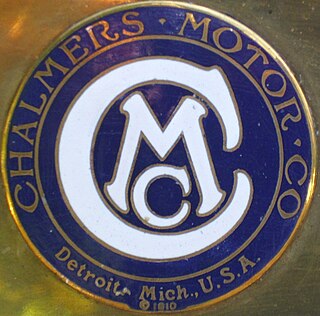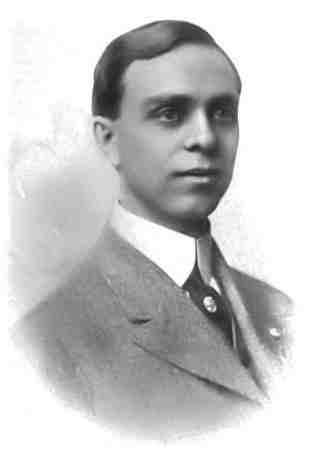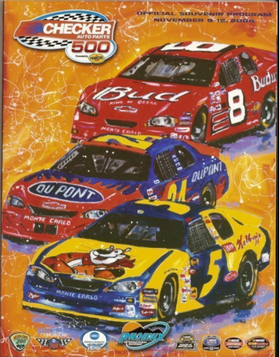
The Chalmers Motor Company was an American automobile manufacturer headquartered in Detroit, Michigan. Founded in 1908 by Hugh Chalmers, the company was known for producing high-end vehicles. Chalmers automobiles gained recognition for their toughness, durability, and engineering receiving particular praise for their performance in touring events. The company reached its peak in 1911, becoming the eighth-largest auto producer in the United States. Despite initial success, the company faced challenges with increasing competition in the auto industry, and sales began to decline in the following years. In 1923, Chalmers Motor Company merged with Maxwell Motor, ultimately forming the basis for the Chrysler Corporation.

American Automobile Association is a federation of motor clubs throughout North America. AAA is a privately held not-for-profit national member association and service organization with over 60 million members in the United States and Canada. AAA provides services to its members, including roadside assistance and others. Its national headquarters are in Heathrow, Florida.

An antique car is an automobile that is an antique. Narrower definitions vary based on how old a car must be to qualify. The Antique Automobile Club of America defines an antique car as over 25 years of age. However, the legal definitions for the purpose of antique vehicle registration vary widely. The antique car era includes the Veteran era, the Brass era, and the Vintage era, which range from the beginning of the automobile up to the 1930s. Later cars are often described as classic cars. In original or originally restored condition antiques are very valuable and are usually either protected and stored or exhibited in car shows but are very rarely driven.
The Automobile Club of Southern California is the Southern California affiliate of the American Automobile Association (AAA) federation of motor clubs. The Auto Club was founded on December 13, 1900, in Los Angeles as one of the nation's first motor clubs dedicated to improving roads, proposing traffic laws, and improvement of overall driving conditions. Today, it is the single largest member of the AAA federation, with almost 8 million members in its home territory of Southern California, more than 16 million members across all subsidiaries in 21 states, and an annual budget in excess of $2 billion.

Checker Motors Corporation was a Kalamazoo, Michigan, vehicle manufacturer and tier-one subcontractor that manufactured taxicabs used by Checker Taxi. Morris Markin established the company in 1922, initially named the Checker Cab Manufacturing Company, in Chicago through a merger of Commonwealth Motors and Markin Automobile Body. The manufacturer moved to Kalamazoo in 1923 and was renamed to Checker Motors in 1958.

Racing flags are traditionally used in auto racing and similar motorsports to indicate track conditions and to communicate important messages to drivers. Typically, the starter, sometimes the grand marshal of a race, waves the flags atop a flag stand near the start/finish line. Track marshals are also stationed at observation posts along the race track in order to communicate both local and course-wide conditions to drivers. Alternatively, some race tracks employ lights to supplement the primary flag at the start/finish line.
Hemmings Motor News is a monthly magazine catering to traders and collectors of antique, classic, and exotic sports cars. It is the largest and oldest publication of its type in the United States, with sales of 215,000 copies per month, and is best known for its large classified advertising sections. The magazine counts as subscribers and advertisers practically every notable seller and collector of classic cars, including Jay Leno and his Big Dog Garage, and most collector car clubs are included in its directory.
Holman-Moody is an American racecar manufacturer, marine engine manufacturer and former auto racing team. The company currently operates out of Charlotte, North Carolina, but is no longer a race team. Holman-Moody continues to manufacture racing vehicles using vintage parts and methods, along with special editions of modern Ford sports cars. The race team built virtually all of the factory Ford racing vehicles of the 1950s, 1960s, and 1970s. It owned race cars that competed in NASCAR, drag racing, ocean boat racing, rallies, and sports car racing. The team won NASCAR championships in 1968 and 1969 with driver David Pearson and also the 1967 Daytona 500 with Mario Andretti. Their most recognized trademark is "Competition Proven."

Race results from the automobile and motorcycle races contested at the Indianapolis Motor Speedway in Speedway, Indiana. Races have been held on seven different track configurations:

Lakewood Speedway was a race track located south of Atlanta, Georgia, in Lakewood, just north of the eastern arm of Langford Parkway. The track held many kinds of races between 1919 and 1979, including events sanctioned by AAA/USAC, IMCA, and NASCAR. It was a one-mile (1.6 km) dirt track which was located adjacent to Lakewood Fairgrounds. Lakewood Speedway was considered the "Indianapolis of the South" as it was located in the largest city in the Southern United States and it held an annual race of the Indy cars.

Oliver Parker Fritchle was an American chemist, storage battery innovator, and entrepreneur with electric vehicle and wind power generation businesses during the early twentieth century. His initial battery patent was awarded in 1903 and by 1904 he had established what was to become the Fritchle Automobile & Battery Company in Denver, Colorado. He was an early adaptor and developer of significant automotive technologies, such as regenerative braking and hybrid drivetrains, that did not reemerge on production vehicles of major car companies until late in the twentieth century.

Charles Jasper Glidden was an American telephone pioneer, financier and supporter of the automobile in the United States. Charles Glidden, with his wife Lucy, were the first to circle the world in an automobile, and repeated the feat in 1908.
The 1957 NASCAR Grand National Series saw driver Buck Baker win his second consecutive NASCAR Grand National Series championship. Baker won the championship with 10,716 points over second place driver Marvin Panch (9,956), and Speedy Thompson (8,560). Baker was the first driver to win back-to-back NASCAR championships. Baker accumulated $30,764 for his efforts in the 1957 NASCAR season. Ken Rush was Rookie of the Year, and Fireball Roberts took home the Most Popular Driver Award.
Gustav Carl Frederick Monckmeier was an American racing driver and inventor. He is known for his participation in the 1911 and 1912 1,000-plus-mile Around Lake Michigan reliability races, which he recreated in 1961.

The 2006 Checker Auto Parts 500 Presented by Pennzoil was a NASCAR Nextel Cup Series racing event that took place on November 12, 2006, at Phoenix International Raceway in Avondale, Arizona.

Joan Newton Cuneo was an American racing driver. Between 1905 and 1912, she was successful in races against both male and female racers until the racing associations restricted races to men only. After women were banned from organized racing, she concentrated on setting women's speed records. Cuneo was a strong advocate for women drivers and an advocate for the Good Roads Movement in the United States. Until recently, she had received only a brief mention in automotive history "as the woman who got women banned from racing."

Augustus Thomas Post Jr. was an American adventurer who distinguished himself as an automotive pioneer, balloonist, early aviator, writer, actor, musician and lecturer. Post pursued an interest in transportation of every form. In 1898, when Post was 25, following his time at Harvard Law School, he circumnavigated the globe by rail and steamship. He then bought one of the earlier made automobiles, crafted by Charles Duryea, and helped found the Glidden Auto Tours, an automotive distance drive and competition used to promote a national highway system. He was the original founder, in 1902, of what is now the American Automobile Association (AAA), first known as the Auto Club of America. He established the nation's first parking garage, the first bus service, and also received the first driving ticket in New York.
Auto racing began in the mid-19th century. It became an organized sport in the early 20th century and has grown in popularity ever since.
The 1956 NASCAR Grand National Season began on November 13, 1955, and ended on November 18, 1956, lasting slightly longer than a full year.
The Merrimack Valley Course was a temporary street circuit in Lowell, Massachusetts. The 10.6 mile track hosted its first races in 1908 and was on the 1909 AAA Championship Car schedule. Due to financial losses, racing was discontinued after that season.














